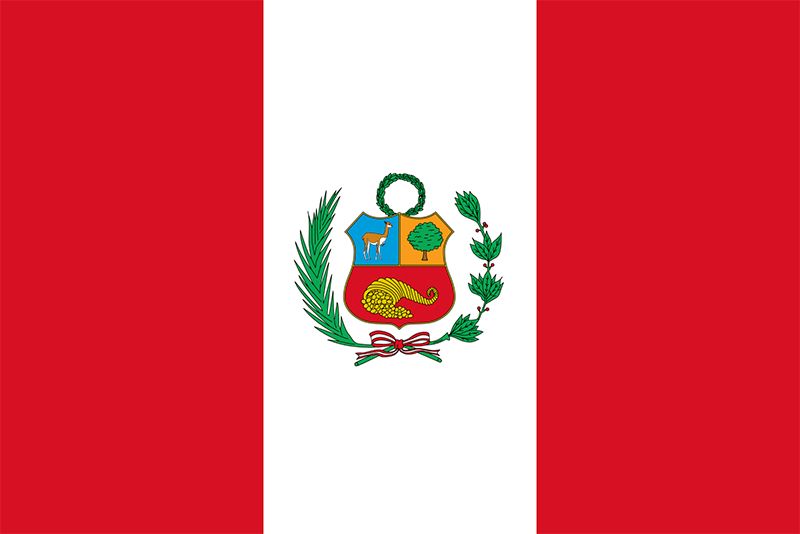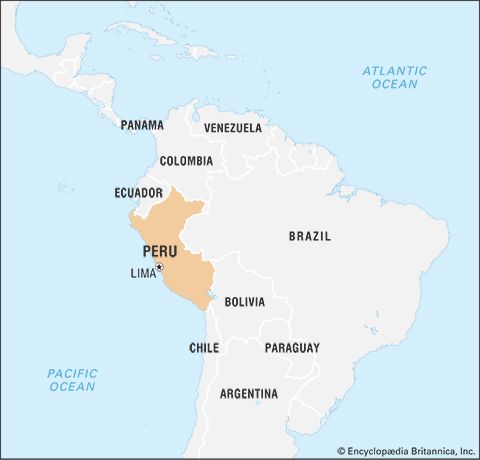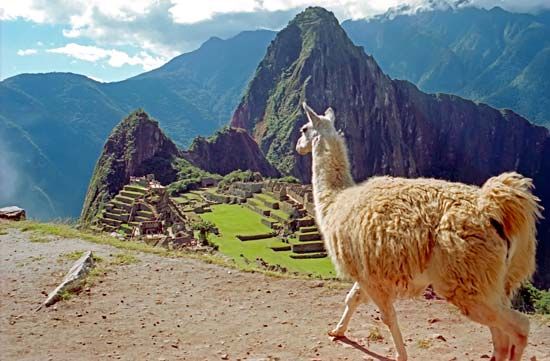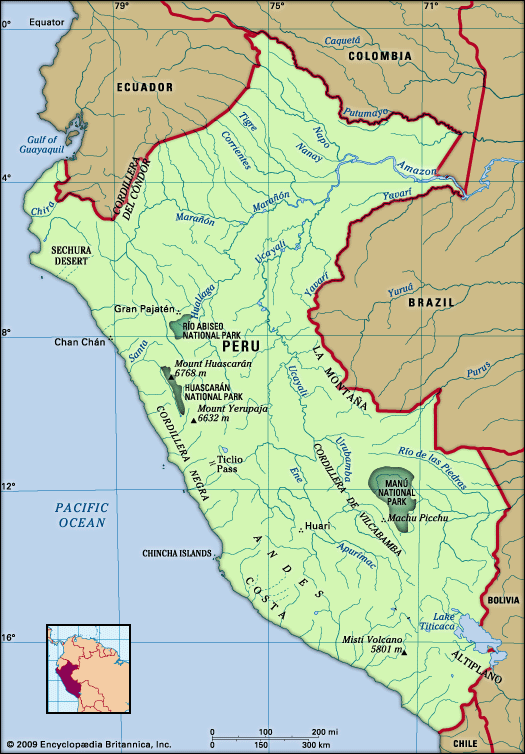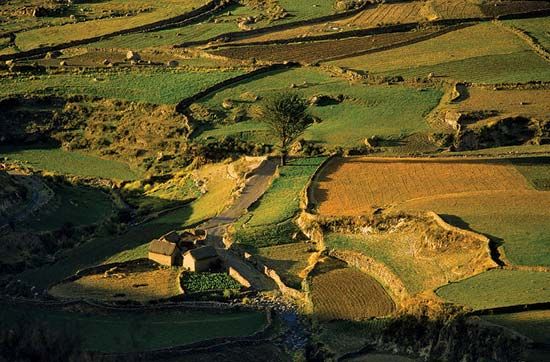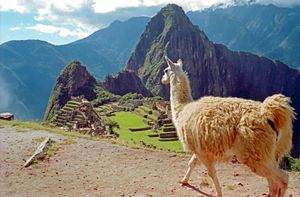Peru
News •
Peru, country in western South America. Except for the Lake Titicaca basin in the southeast, its borders lie in sparsely populated zones. The boundaries with Colombia to the northeast and Brazil to the east traverse lower ranges or tropical forests, whereas the borders with Bolivia to the southeast, Chile to the south, and Ecuador to the northwest run across the high Andes. To the west, territorial waters, reaching 200 miles (320 km) into the Pacific Ocean, are claimed by Peru.
Peru is essentially a tropical country, with its northern tip nearly touching the Equator. Despite its tropical location, a great diversity of climates, ways of life, and economic activities is brought about by the extremes of elevation and by the southwest winds that sweep in across the cold Peru Current (or Humboldt Current), which flows along its Pacific shoreline. The immense difficulties of travel posed by the Andes have long impeded national unity. Iquitos, on the upper Amazon, lies only about 600 miles (965 km) northeast of Lima, the capital, but, before the airplane, travelers between the cities often chose a 7,000-mile (11,250-km) trip via the Amazon, the Atlantic and Caribbean, the Isthmus of Panama, and the Pacific, rather than the shorter mountain route.
- Head Of State And Government:
- President: Dina Boluarte
- Capital:
- Lima
- Population:
- (2024 est.) 34,096,000
- Form Of Government:
- unitary multiparty republic with one legislative house (Congress of the Republic [130])
- Official Languages:
- Spanish; Quechua (locally); Aymara (locally)
- Official Religion:
- none1
- Official Name:
- República del Perú (Spanish) (Republic of Peru)
- Total Area (Sq Km):
- 1,285,082
- Total Area (Sq Mi):
- 496,171
- Monetary Unit:
- nuevo sol (S/.)
- Population Rank:
- (2023) 43
- Population Projection 2030:
- 35,900,000
- Density: Persons Per Sq Mi:
- (2024) 68.7
- Density: Persons Per Sq Km:
- (2024) 26.5
- Urban-Rural Population:
- Urban: (2017) 79.3%
- Rural: (2017) 20.7%
- Life Expectancy At Birth:
- Male: (2020–2025) 74.5 years
- Female: (2020–2025) 79.8 years
- Literacy: Percentage Of Population Age 15 And Over Literate:
- Male: (2020) 97%
- Female: (2020) 92%
- Gni (U.S.$ ’000,000):
- (2022) 230,634
- Gni Per Capita (U.S.$):
- (2022) 6,770
- The state recognizes Roman Catholicism as an important element in the historical and cultural development of Peru.
The name Peru is derived from a Quechua word implying land of abundance, a reference to the economic wealth produced by the rich and highly organized Inca civilization that ruled the region for centuries. The country’s vast mineral, agricultural, and marine resources long have served as the economic foundation of the country, and, by the late 20th century, tourism had also become a major element of Peru’s economic development. Favourite destinations for international travelers include Machu Picchu, a site of ancient Inca ruins located about 50 miles (80 km) northwest of Cuzco, and museums housing artifacts excavated from ancient tombs in northern coastal Peru.
Land
Relief
Peru is traditionally described in terms of three broad longitudinal regions: the arid Costa on the west; the rugged Sierra, or Andes, system in the centre; and the wet and forested Amazonia—the tropical Amazon Basin—on the east.
The Costa
The coastal plain can be readily divided into three parts—north, central, and south—on the basis of the amount of level land and the distance between the Andean ranges and the sea. Generally speaking, the amount of level coastal land diminishes from north to south. In the northern region, from Ecuador to Chimbote, the plain is typically some 20 to 30 miles (30 to 50 km) wide, with a maximum width of more than 90 miles (140 km) in the Sechura Desert south of Piura. The central coastal region, which stretches from Chimbote to Nazca, is narrower than the northern region and is characterized by areas of rough hills that extend from the Andes to the shores of the ocean. From Nazca southward to the Chilean border the coast is for the most part lined by low mountains; the southern valleys are narrow, and only in scattered spots are level lands found near the ocean.

The Sierra, or Andean, region
Along the western edge of South America, the Andes Mountains were created by tectonic activity in which the South American Plate overrode the Nazca Plate. The Peruvian Andes are typical of mountain regions of the Pacific Rim: they are young in geologic terms, and their continuing uplift is manifested by frequent earthquakes and much instability. Three main backbones protrude from the Peruvian Andes; they are commonly called the cordilleras Occidental, Central, and Oriental, although these designations are not used within Peru.
Slopes are relatively gentle in northern Peru, and maximum elevations seldom exceed 16,000 feet (about 5,000 metres). The Andes in central Peru are higher and more rugged. The ranges of the central zone form particularly difficult barriers to movement. The main pass east of Lima, for instance, is at an elevation of more than 15,000 feet (4,500 metres)—higher than many of the peaks in the north. Many of the mountains of central Peru are snowcapped and are a popular attraction for climbers and tourists. Of particular fame is the Cordillera Blanca, with the country’s highest peak, Mount Huascarán, at 22,205 feet (6,768 metres), and nearby Huascarán National Park (designated a UNESCO World Heritage site in 1985). In southern Peru the character of the Andes changes to that of a high plateau region; this is the Puna, with vast tablelands and elevations between 13,000 and 16,000 feet (about 4,000 and 5,000 metres). Scattered peaks, with elevations of up to about 21,000 feet (6,400 metres), protrude above the broad southern plateaus. Beginning northwest of Arequipa, many of the southern peaks form a volcanic chain that stretches into northern Chile, including Ampato, Huacla Huacla, and Misti.

